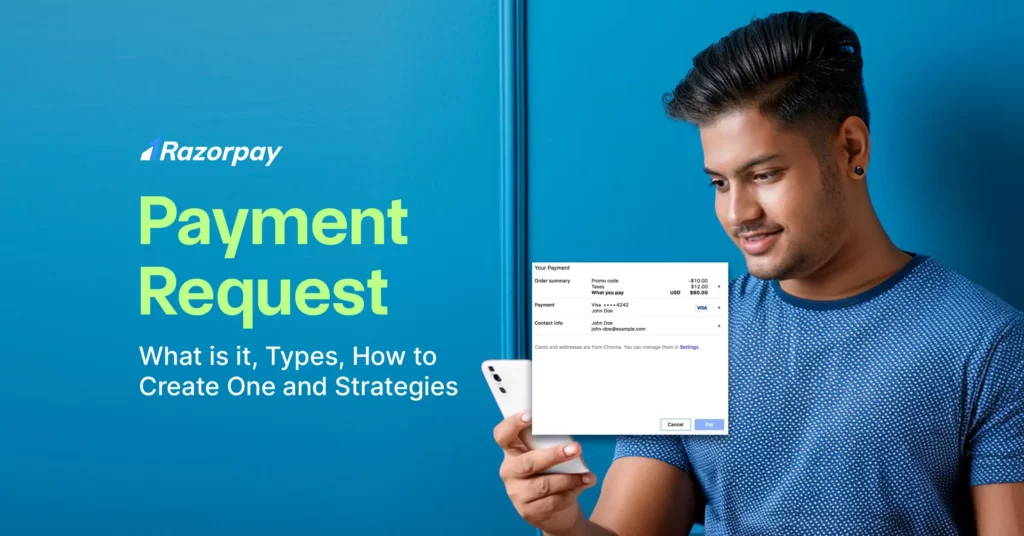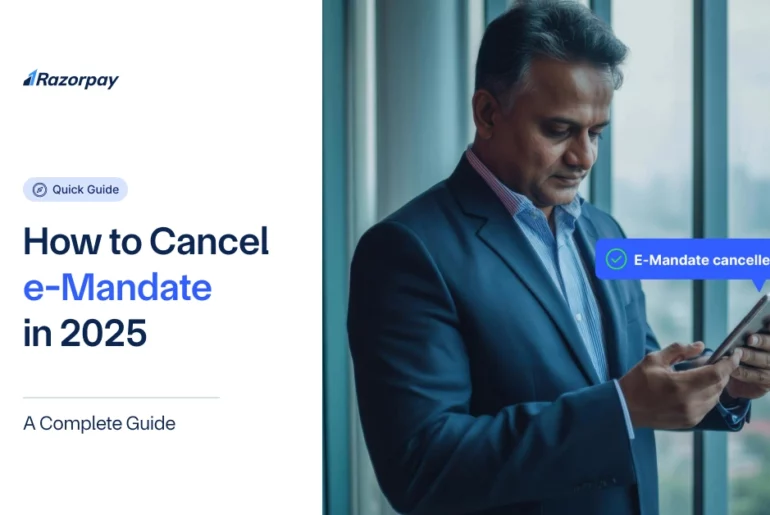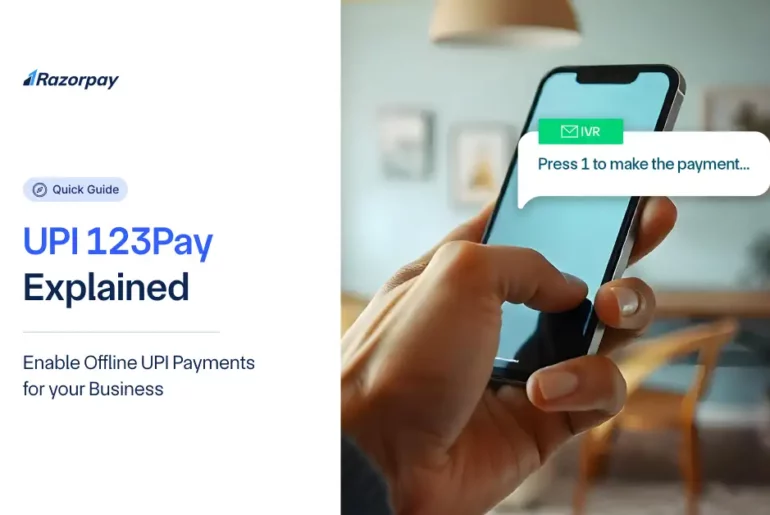Table of Contents
What Is a Payment Request?
A payment request collects payments by sending a link or URL that directs customers to a payment page. This page can have clickable links or QR codes and can be sent through e-mail or messaging apps. Upon clicking these payment request links, customers are directed to a secure page where they can enter payment details and complete the transaction.
Payment requests simplify the payment process for both businesses and customers. They eliminate the need for manual entry of payment information and provide a seamless experience.
What Are the Types of Payment Requests?
1. Payment Links
They allow you to generate unique URLs that customers can share via e-mail or messaging applications. Payment links offer customization options, allowing you to add branding and customize the payment page’s appearance. However, people might fear that payment links can be manipulated to create fake links for phishing scams.
2. Online Invoices
Online invoices provide a professional look and detailed breakdown of products or services rendered. They can be easily integrated with accounting software, thus simplifying bookkeeping processes. However, they may need more flexibility regarding customization and ease of use.
3. E-mail Requests with Payment Buttons
You can send payment requests via e-mails with embedded payment buttons. This method simulates traditional payment methods like credit card terminals. It is easy to integrate into e-mail workflows. However, it may need a more professional look at online invoices and detailed breakdowns.
How Does a Payment Request Work?
The payment request process typically involves the following steps:
Request Generation
The sender (payee) creates a payment request, specifying the amount, due date, and relevant details. This request is often sent through email, SMS, or a dedicated payment platform.
Recipient Notification
The recipient (payer) receives the payment request and reviews the details. The request may include a link or QR code for easy access to the payment page.
Payer Action
The payer clicks on the payment link or scans the QR code, which redirects them to a secure payment page. They can then choose their preferred payment method (credit card, debit card, bank transfer, etc.) and complete the transaction.
Payment Processing
The payment is processed through the chosen payment method, and the funds are transferred from the payer’s account to the payee’s account.
Confirmation
Both the payer and payee receive confirmation of the payment, including transaction details and receipts.
Common Use Cases of Payment Requests
Payment requests have become increasingly prevalent in various sectors, offering convenience and efficiency for both businesses and individuals.
Business Transactions
- Invoice payments: Businesses can send payment requests to clients for outstanding invoices, streamlining the collection process.
- Supplier payments: Companies can initiate payment requests to vendors, improving cash flow management.
- Expense reimbursements: Employees can submit payment requests for business-related expenses.
Freelancers and Contractors
- Client payments: Freelancers and contractors can send payment requests to clients for services rendered.
- Project milestones: Payment requests can be linked to specific project milestones.
Subscription Services
- Recurring payments: Subscription-based businesses can utilize payment requests for automatic renewals and one-time charges.
- Payment reminders: Customers can be sent gentle reminders before the due date.
Personal Transactions
- Splitting bills: Friends and family can use payment requests to divide expenses for shared experiences.
- Collecting funds: Individuals can request contributions for gifts or group purchases.
How to Create Payment Requests?
1. Platform Selection
To create payment requests, choose a suitable payment processing service or invoicing platform. You must look for the best payment gateway in India that offers easy integration, secure transactions, and multiple payment options.
2. Account Setup
Create an account on your chosen platform by providing the required information, such as your business details, bank account details, and contact information.
3. Payment Details
Enter the necessary information on the platform for each pay request, including the amount to be paid, a description of the product or service, and customer information such as name and e-mail address.
4. Customization
Some platforms allow customization for your payment requests. Add your business logo or branding elements to provide a professional touch.
5. Sharing the Request
You can send a unique link generated directly to the customer via e-mail or messaging apps, or attach an invoice with all the necessary details.
Benefits of Payment Request Links
-
Payment request links streamline the process by eliminating the need for lengthy checkout forms or traditional invoicing. Customers can make payments conveniently with just a click.
-
You can schedule automatic reminders to ensure timely notifications about pending payments. This reduces the need for manual follow-ups and improves cash flow.
-
Payment request links support various payment methods, including credit cards, bank transfers, and in-app payments.
-
Payment request services enable currency exchange, making it convenient for international customers to pay in their local currency. This can help your business expand its global reach and increase sales.
Related Read: What is SWIFT Payment?
Effective Strategies For Timely Payment Collection
1. Utilize Payment Request Links
Using payment request links, such as GoCardless’ Instant Bank Pay service, simplifies the payment process by enabling instant, bank-to-bank transfers. Customers can complete payments with just one click, streamlining the entire transaction.
2. Maintain Precise Records
Keeping accurate records with accounting software is crucial for tracking all received payments. This ensures that no payment goes unnoticed and aids in financial management.
3. Set Clear Payment Expectations
Establish clear payment terms upfront through contracts. This sets the groundwork for timely payments and helps prevent misunderstandings later on.
4. Request Deposits in Advance
Securing a deposit before starting work can reduce the risk of late payments. It ensures customer commitment and provides a financial buffer for your business.
5. Choose a Reliable Payment Processor
Select a trustworthy payment processor that integrates seamlessly with your business systems. Modern banking tools can enhance cash flow by facilitating consistent, timely payments.
Related Read: What is IVR Payment and How to Make IVR Payments?
Frequently Asked Questions
1. Why is sending a payment request important for businesses?
Sending a payment request streamlines the payment collection process. It eliminates the need for manual follow-ups and reduces the chances of errors in payment information.
2. What are the key components of an effective payment request?
A payment request should include clear details, including the amount due, the due date, and acceptable payment methods. It should be personalized with the recipient’s name and contact details.
3. Can payment requests be automated and what are the benefits of doing so?
Yes, payment requests can be automated using payment solution providers or payment link APIs. Automating the process saves time and effort by eliminating manual intervention. It offers convenience to both businesses and customers, improves cash flow management, and reduces administrative overheads.
4. Is a payment request the same as an invoice?
A payment request is not the same as an invoice. While both serve as a means of requesting payment from customers, a payment request is a simplified version that focuses solely on requesting payment without itemized details.
5. Are payment requests secure?
Yes, payment requests have security measures to protect sensitive customer information.
6. What types of payment methods are usually accepted in payment requests?
Payment requests typically accept a wide range of payment methods, including credit and debit cards, NetBanking, UPI, mobile wallets, and other online payment options.
7. What happens if a payment request expires?
If a pay request expires before a customer makes the payment, you might need to raise a new payment request.



